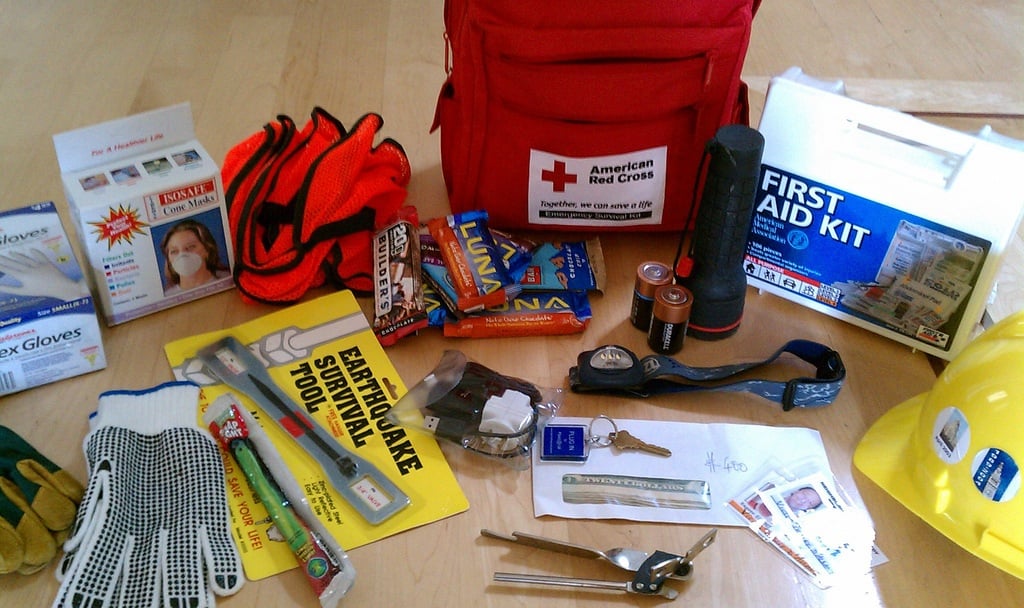This doesn’t mean that we should all create bunkers in our basements, filled with Spam, military rations and chemical toilets. There are a few items that each and every one of us could and should keep on hand, just in case. We never know when some weirdness will strike. It’s better to have something and not need it, than need it but not have it.
A Bucket for Every Person
A large 5-gallon bucket is the perfect size to contain all of the supplies a single person needs to get through the first 72 hours of an emergency situation. The average kit will include a few basics that everyone needs. This is a guideline, but it’s best to customize the kits for each person. In general, buckets should have as many of the following items as possible:
General Supplies:
Utility knife (Swiss Army, Leatherman, etc.) Dust mask Whistle Flashlight Insulating blankets (mylar reflective emergency ones) Strike-anywhere matches Can opener Cutlery/utensils (fork, spoon, knife, chopsticks, cooking spoon) Candles (a few per day) Sewing kit Household twine Portable cooking stove Fuel A small tarp Duct tape (1 roll per bucket) Pencils A couple of garbage bags Laminated list of emergency phone numbers (relatives, police, ambulance, insurance, etc.) Cash money (if debit and credit cards can’t be used for a while)
Hygiene Products:
Pack of 10 tissues (1 or 2 of these) Travel shampoo Hand cream A bar of soap (in a plastic travel container) Sunscreen Comb or brush Toothbrush and toothpaste (travel size are fine) Dental floss 1 roll of toilet paper A wash cloth For women: tampons/pads (a 3-day supply)
Clothing:
Underwear (2 or 3 pairs) Clean, warm socks (2 pairs) Gloves
Photo by Global X, via Flickr
First Aid Kit:
A basic emergency first aid manual Ibuprofen (Advil) Acetaminophen (Tylenol) Aspirin Hydrocortisone cream Triple antibiotic cream (Neosporin) Tweezers Cotton swabs (Q-tips) Hand sanitizer gel A selection of adhesive bandages Gauze rolls and pads Waterproof adhesive tape Thermometer Cough drops/sore throat drops Burn ointment Crazy glue (can be used to seal cuts) Allergy medication Antidiarrheal (Immodium) Triangular bandage Notebook and pencil *Any personal medications (heart medications, birth control pills, etc.)
*Note: If you keep a supply of any kind of medication in your kit, it’s important to rotate it on a regular basis in order to keep it fresh and effective. No-one wants to be caught in an emergency situation only to discover that their medications have expired. Medication, such as insulin that must be refrigerated, should be stored per its instructions as long as possible, and it’s important to check how long these medications will maintain efficacy, if refrigeration is unavailable.
Food/Water:
When it comes to food and water, it’s good to have 1 gallon of water per person, per day, and approximately 2,000 calories’ worth of food. Keep in mind that all edibles should be shelf stable/non perishable. It’s important to ensure that the foods set aside for each person are those that can actually be eaten! Many pre-made preparedness kits have a great selection that those without any food allergies or sensitivities can appreciate, but if there are any special diets that need to be adhered to, it’s best to assemble your own. It would be bad for a gluten-free, soy-sensitive vegan to be stuck in an emergency situation and discover that the only things to eat are freeze-dried eggs and meaty-wheaty bites in teriyaki sauce. Some food options may include:
Canned food such as fruits, vegetables, stews, and puddings Canned protein sources (corned beef, tuna) Milk and juice, in boxes or cans Pre-prepared beans Dried sausages/jerky Trail mix that has nuts, seeds, and dried fruit Granola bars Crackers (go for low-sodium, as anything salty will make you thirsty) Cookies Dry cereal Instant meal packets (oatmeal, cream of wheat, dehydrated camping foods) Instant noodles Nut butters
Although you may think that your own personal survival kit should be well stocked with Fritos, soda, chocolate chip cookies, and vodka, it’s best to aim for a more well-balanced diet. You can slip in a couple of comfort foods as well, but nutrition takes precedence over candy binges in these situations. If you have pets, remember to make buckets for them as well! Dogs, cats, small mammals, birds, and reptiles all have their own unique needs, so be sure to stock a few days’ worth of any supplies your animal companions need, too. Cats and dogs should have harnesses and leashes in their buckets, birds and little creatures should have small travel cages at hand to keep them safe, and it would be good to keep a guide to emergency pet care in their pail too. Most human medications can’t be given to or used on pets, with the exception of hydrogen peroxide and some antibiotic ointments. Research what is and isn’t safe for your companions, and then pack a small supply of medication that is pet-safe, just in case.
A Week’s Worth of Wellbeing
Some less-than-stellar situations may take a bit longer than 3 days to sort out, so in addition to the bucket-per-person as mentioned above, it’s a good idea to keep some additional items in stock at your home. The ideal storage place remains dry at all times, and has a consistent temperature that’s neither too hot, or too cold. An ideal spot would be a pantry, closet, or cupboard on either the main floor or lower level of your home. If the basement is prone to dampness or cold spots, it’s important to insulate it first. Consider this supply closet as an extension of your bucket. You can also use this space for larger items that may not fit in your pails, such as extra cooking fuel, a water purification pump filter, or even a tent. The Boy Scout’s motto is “always be prepared”, and honestly, it’s a good motto for everyone to follow. Take care of yourselves, please.
